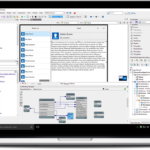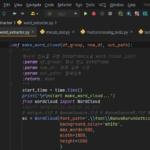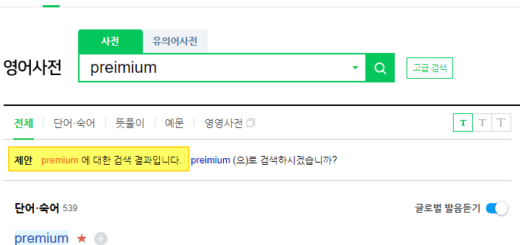About the triple keyboard
I use a three-dimensional keyboard. I think the three-dimensional keyboard is the most effective keyboard for Korean input. Take a look at the advantages and disadvantages of three types, comparison of two types and keyboards, types of three types, Windows/MacOS/Linux input methods, and precautions for use.
In 2001, I learned and started using the three-stroke final, and around 2010, I changed to the three-stroke 390 keyboard and have been using it ever since.
Around 2001, I used the mouse a lot (playing StarCraft, which was popular at the time, too hard.. ^^;;), causing severe pain to my right wrist, elbow, shoulder, and neck. I tried using the mouse by moving it to my left hand, but it didn't adapt well and the work efficiency was low, so I needed a solution.
The method chosen at this time was to minimize the use of the mouse and use the keyboard as much as possible.
As I used the mouse only when absolutely necessary and used keyboard shortcuts most of the time, the pain gradually decreased. While thinking about how to make keyboard input more efficient and effective, I changed two things.
- Changed to three-dimensional keyboard: It was said that the three-dimensional keyboard is less fatigued when typing in Korean, so it took about a month to fully adapt. (At first, the three-dimensional final (391) keyboard, later settled on the 390 keyboard)
- Changed membrane keyboard to mechanical keyboard: After going through Aaron, Alps, and Cherry (black/white/blue/brown/red) series, it settled as a capacitive (silent) keyboard after 2009. This topic will be dealt with separately later.
In this article, we will briefly review the three-dimensional expression.
1. What is three-dimensional keyboard?
Some excerpts from the contents of Wikipedia and Namu Wiki.
The triple-type keyboard is a Korean keyboard that divides Hangul letters into three sets (one first sound, one middle sound, and one final sound), and letters with different sets are put in different key positions or entered in different input methods. The most widely known type is the Gongsebul type keyboard from the typewriter keyboard developed by Gong Byung-woo. The triple-type shorthand keyboards and the new three-type shorthand keyboards put into practical use after the 1990s also belong to the three-type keyboard.
* source: Three-stroke keyboard - Wikipedia, the everyone's encyclopedia (wikipedia.org)
First developed in 1949 by Dr. Gong Byung-woo, a system for inputting letters by dividing them into initial consonants, neutral consonants, and final consonants. It is a three-letter type because the letters are divided into three sets, one for the initial, middle, and final consonant. On the other hand, it is called two-beol-sik because it is divided into two sets of consonants and vowels. Therefore, if you call it 'Three Beolsik', it is a wrong expression. When counting clothes, 'one suit, two suits, three suits...' ' It's the same as saying.
* source: https://namu.wiki/w/Sebulsik #s-1
In summary, the three-character keyboard layout was developed by Dr. Gong Byeong-woo and is divided into initial consonants (first sound), middle consonants (middle sounds), and final consonants (final sounds).

source: https://commons.wikimedia.org/wiki/File:Gong Byungwoo_Keyboard_Texture.png
2. Advantages of three-dimensional keyboard
(source: Let's use the three-part ceremony – campaign site (https://sebeolsik.kr))
- fast
- It is comfortable
- fewer typos
2.1. fast.
I didn't need to type fast, but after adapting to the three-stroke, it was more than 50 strokes faster than the two-stroke. The two rounds were about 300 to 350 strokes long, and the three rounds were about 350 to 400 strokes.
2.2. It is comfortable.
In my case, after changing to the three-piece type, my hands became really comfortable. You hardly press the Shift key, which puts too much strain on your hands, and the mainly used consonants and vowels are placed almost in the center, so the hand movement distance is small and the force applied to the fingers is small.
It is the most satisfying thing to change to a three-piece meal.
2.3. Fewer typos.
Certainly, there are fewer typos compared to the two beolsik. It seems that the reason for this is that I got into the habit of making a lot of typos out of a desire to hit quickly when I first learned the two-beol-sik, but I think that the three-beol-sik has a sense of rhythm in the movement of the fingers, so there are relatively few typos.
3. Disadvantages of the three-dimensional keyboard
- It is not a standard keyboard.
- It takes a long time to learn the first time compared to the two beolsik.
3.1. It is not a standard keyboard.
The three-dimensional keyboard is not a standard keyboard. The official standard keyboard in Korea is the double keyboard (KS X 5002).
There are many people who don't even know that there is a keyboard called sebulsik. No, it seems more accurate to say that very few people know that there is a ceremony.
Although OSs such as MS Windows, macOS, and Linux all support three keyboards, the default is set to two keyboards. These OSs support the use of three final (391) and 390 keyboards.
(For reference, the meaning of the 'final keyboard' in the three-dimensional final keyboard is 'the last keyboard designed by Dr. Byung-Woo Kong himself'.)
3.2. It takes a long time to learn the first time compared to the two beolsik.
The two-row type uses a three-line key arrangement, and the three-line key arrangement uses a four-line (including numeric keys) key arrangement. The double type is the keyboard of two consonants + vowels, and the three keys are the three keyboards of the initial + neutral + final. The initial consonant 'ㄱ' and the final consonant 'ㄱ' are placed on different keyboards.
It can be said that it takes relatively longer to adapt compared to the double diet.
3.2.1. Comparison of two- and three-dimensional keyboards
The arrangement of the two keyboards, the three final keyboards (391), and the 390 keyboards is as follows.

* source: Double keyboard - Wikipedia, the everyone's encyclopedia (wikipedia.org)

* source: Three-stroke keyboard - Wikipedia, the everyone's encyclopedia (wikipedia.org)

* source: Three-stroke keyboard - Wikipedia, the everyone's encyclopedia (wikipedia.org)
Unlike the final (391) keyboard, the three-digit 390 keyboard assigns special symbols to Shift + number keys.
4. Three types of keyboards
Since the three-dimensional expression is not standard, many variations have been made. The types of three-dimensional keyboards are well organized in Namu Wiki, so they are replaced with links.
Three-dimensional/keyboard type – Namu.wiki
Three types/Keyboard types/Others – Namu.wiki
4.1. Criteria for selection of 3 final (391) and 3 390
When entering a lot of special symbols (@, #, $, %, ^, &, *, (, ), [, ], {, }…, etc.) And, if you rarely input special symbols, the three-form final (391) is suitable.
In my case, I work as an IT engineer or consultant, so I have to type in special symbols a lot, and I use 390 much more comfortably than the final three (391) I learned at first.
5. Three type input method
In addition to the input methods provided by default in Windows and macOS, three types of input methods that can be used are as follows.
- Windows: Wingset Hangul input method (Wingset Hangul Input Method 10.4 (new21.org))
- macOS: cloud input (Gooreum Input - New Hangul Input for macOS (gureum.io))
In Linux, if you use one of ibus, fcitx, uim, and nabi, you can enter it in three expressions.
6. Precautions when using the three-course meal
If you use three sets of formulas on a computer shared by several people, you need to change the setting to two sets. If a user inputs Hangul in a state where the two-beol type is set to three-beol type, it is entered strangely and may be misunderstood as having a virus.
So far, we have briefly reviewed the three beolsik. I've been using the three-stroke keyboard for over 20 years, and I've never gone back to the two-stroke keyboard. Rather, it is awkward every time I enter a double expression.
It is hoped that the three-dimensional keyboard will settle well as a plural standard along with the two-dimensional keyboard.













